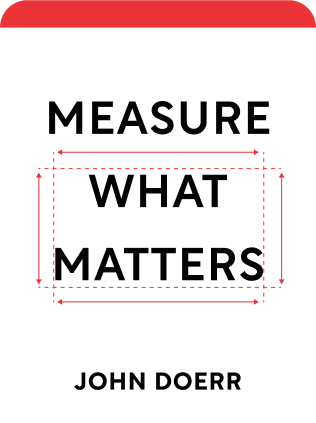

This article is an excerpt from the Shortform summary of "Measure What Matters" by John Doerr. Shortform has the world's best summaries of books you should be reading.
Like this article? Sign up for a free trial here .
What is a top-down organizational structure? Are there other types of organizational structures? Which is best?
A top-down organizational structure is the default for many businesses and other organizations. But many argue that a top-down organizational structure isn’t actually the most effective.
Find out more about top-down organizational structures, and alternatives based on OKRs.
Top-Down Organizational Structure vs. Bottom-Up Organizational Structure
Generally, there are two approaches to alignment: top-down and bottom-up. In the top-down organizational structure, directives start with the CEO and cascade down through the ranks to the junior employees. In the bottom-up approach, junior employees working on the frontlines, the people who often have the most access to customers and product issues, identify pressing needs and relay them up the chain of command to the CEO.
There are benefits to both systems, and the most effective companies are aligned in both directions. However, there are more problems with a top-down management structure than with bottom-up organizational structure.
Problems with Top-Down Organizational Structure
The benefit of a top-down management structure and goal-setting system is that it ensures everyone’s goals are aligned with the company’s vision. But there are five problems that outweigh this benefit:
Problem #1: Top-Down Systems Aren’t Efficient
Before the manager can set goals for his team, he has to wait for the department head to give him his own goals, and the department head has to wait for her own marching orders from the executive team. This process of goal-setting can take weeks, and with markets that are constantly changing, companies need to pivot quickly.
Problem #2: Top-Down Systems Aren’t Flexible
Related to Problem #1, top-down goals are hard to change mid-cycle if they’re not working. If a department head realizes that he needs to adjust his goal to meet the needs of changing circumstances, all the employees in tiers below him will have to scramble to revise their own goals to align with his. This kind of system isn’t sustainable.
Problem #3: Top-Down Systems Don’t Value the Insight of Frontline Employees
Often, employees at the lowest tiers have the most interaction with the market, and they may be the first to know that a company’s strategy isn’t working. A top-down system can marginalize these employees and make it difficult for them to communicate their concerns to those with the power to change things.
Problem #4: Top-Down Systems Don’t Connect People Horizontally
While these systems provide a clear path from the top of the organization to the bottom, they don’t connect people with employees from other departments. Consequently, the organization loses valuable opportunities to foster interdepartmental collaboration.
Problem #5: Top-Down Systems Fail to Motivate Employees
Because employees don’t have a say in developing their own goals, they take less responsibility for achieving them. You’re much more likely to reach a goal you set for yourself. Additionally, when employees don’t feel ownership over their goals, their bosses often find themselves micromanaging in order to get things done, and this keeps them from focusing on their own goals.
Benefits of a Top-Down Organizational Structure
Top-down alignment isn’t all bad. In fact, about half of employees’ OKRs should come from objectives established by top management. At its best, top-down alignment makes cascading goals clear. Below, the head coach’s key results become the objectives of the coaches working under him. This is an effective use of top-down alignment. In turn, each coach has his own specialized key results that support his objective.
Head Coach
Objective: Win the Super Bowl
Key Result #1: Offense gains at least 300 yards per game
Key Result #2: Defense allows no more than 17 points per game
Key Result #3: Special teams unit earns a ranking in the top 5 for coverage of punt returns
Offensive Coach
Objective: Offense gains at least 300 yards per game
Key Result #1: Achieve a rate of 60% pass completion
Key Result #2: Allow no more than 2 interceptions per game
Key Result #3: Hire a quarterback coach by the end of July
Defensive Coach
Objective: Defense allows no more than 17 points per game
Key Result #1: Allow no more than 100 rushing yards in one game
Key Result #2: Raise sacks to at least 3 per game
Key Result #3: Train the new cornerback by the end of August
Special Teams Coach
Objective: Special teams unit earns a ranking in the top 5 for coverage of punt returns
Key Result #1: Give up no more than 10 yards for each punt return
Key Result #2: Block at least 3 punts during the season
When objectives do come from the top, let employees give their input on the necessary key results. In the example above, the head coach might direct the special teams coach to make sure the special teams unit earns a top-5 ranking, but it’s up to the special teams coach to decide which key results will get them there.
Benefits of Bottom-Up Organizational Structure
The primary benefit of bottom-up alignment is efficiency. Companies with tens of thousands of employees, like Google, can’t wait for instructions and OKRs to make their way down the chain of command. Innovation requires speed and flexibility, and bottom-up alignment fosters both of these qualities.
The secondary benefit of bottom-up alignment is that it encourages a certain degree of freedom. Because employees get to choose many of their own goals, they feel ownership over them, they’re more motivated to achieve them, and morale improves. This freedom also fosters innovation, which studies show flourishes when employees don’t feel constrained by their managers.
OKRs help bottom-up alignment function smoothly. Individuals and teams are responsible for setting their own OKRs and making sure that these goals help further the company’s objective. Individual and team OKRs are public, so if anyone’s OKRs aren’t aligned with the top-line OKRs, it’s obvious.
It’s possible that a top-down management structure works for you, but it’s likely that if you’re using OKRs, you’ll have to reorganize. Now you have some ideas on other methods.

———End of Preview———
Like what you just read? Read the rest of the world's best summary of John Doerr's "Measure What Matters" at Shortform .
Here's what you'll find in our full Measure What Matters summary :
- How Google uses OKRs to rally 100,000 employees in the right direction
- How to avoid setting useless OKRs, and how to set great ones
- Key subtle behaviors your team must master to make OKRs work






